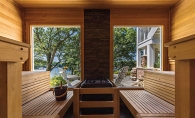“I thrive outside,” enthuses Bradley Agee. “There’s something about being in the moment: in the sun, digging in the soil, placing the plant. It’s about promise—a hopeful gesture—and in this climate, it’s also a lesson in patience.”
Agee is a landscape designer and considers himself part layman scientist, part social planner. He’s worked on Lake Minnetonka area gardens for years, both as a designer and a gardener. He also happens to be the director of Undergraduate Studies and adjunct professor for the Department of Landscape Architecture at the University of Minnesota’s College of Design. And he maintains a small word-of-mouth clientele with his company, Constable-Steele Garden Design.
Agee was born with a green thumb. Even when he lived in New York City, he cultivated a window box. His father was a landscape architect and city planner, and his grandmother was the sort of exacting gardener who would quibble with her lawn maintenance company about the correct shade of green. Agee marvels, “When I found out I could get paid to garden, I was wowed. Who knew this could be a real job?”
Landscape Designer Meets Gardener
Agee has been working with longtime client Susan Wilson of Long Lake for 15 years. They met through a neighbor whose property Wilson admired and on which Agee collaborated. When she moved into her 14-acre estate, there was only a fenced-in corral of vegetables, trees and Long Lake Creek, so Wilson decided to create something personal that she could work on herself. Agee counts Wilson as one of the few clients who is also a gardener, and they share a bond of respect, learning and exchange.
The Wilson property has since evolved into an extensive network of multiple gardens, or a series of different of ecosystems. Agee’s design includes the English cottage garden and circuit walk influenced by 18th century traditions that moves from garden experience to garden experience in a loop, creating progressions, focal points, transitions and progressions throughout the site.
The cottage garden is a mixed border of shrubs, vines and perennials—monarda, echinacea, sedum, peonies, lilies and more—and is minimally cultivated. Agee deliberately chose plants that would flourish. “I want to be as predictive as I can,” he asserts. “I don’t try to muscle my way through or control self-seeding with mulch and foundation fabric because I like things to be carefree and slightly wild.” Agee points out that the right plants are “coded”—they fold when it’s dry, bloom when it’s rainy, and drop their seeds. He avoids dependence on the rare species that might fail, preferring to create a supporting cast of characters that take turns onstage.
Among the Wilson gardens are four raised beds, including a fenced-in vegetable patch and a fairy garden for the aspiring-gardener grandchildren—replete with ponds, a river and the requisite evil witch. Another area of the property is given over to native tall grasses. As a former chairman of the Nature Conservancy, Wilson is committed to prairie restoration, so she “killed and tilled, killed and tilled” to make it happen.
Mutual Learning Experience
For her part, Wilson enjoys the give-and-take relationship she shares with Agee, and learns a lot by watching his decision-making process. “He has a great ability to know when to add structure and when to create freedom, which is what makes a garden interesting,” she observes. In one instance, Agee added boxwood in the corners of the cottage garden to balance the seemingly random profusion.
Wilson learned from Agee to separate and move self-seeding plants instead of buying them. “It’s magical when things come up where you didn’t plan them,” says Wilson. “Brad’s aesthetic is very much about letting natural things happen, whereas I was more tidy and structured.” She adds, “I like working with older, existing sites and responding to a context that has a history, both vegetative and architectural.”
In turn, Agee appreciates Wilson’s vision, noting that “she has a strong perspective and as a result, our work is very collaborative.” Her love of openness may be attributed to her North Dakota roots. According to Agee, “She’s not afraid to take down a tree, which caused some anxiety for me in the beginning. I tend to be more conservative, but she likes her vantage points and long views. She has since made me a believer.”
Agee develops relationships with clients and their land incrementally, as natural environments themselves continue to evolve over the seasons and years. “To some extent, the landscape takes care of itself, but it’s not stagnant,” he says. “The climate’s changing, lakes dry up, you have to be on your toes and stay objective. Often a client wants instant magic, but I prefer to interpret the landscape over time with someone like Susan Wilson, who is invested in her property over time.”
Joys and Sorrows of Minnesota
Surprisingly, the winter season is not a dead time for landscape design and gardening. Agee uses winter months for planning, site analysis and interpretation. He takes pains to consider the look of the landscape in the off-season. “When something’s not in bloom,” says Agee, “we’re still interested in leaf shape, color, stem, branching and effective presentation.” Wilson herself appreciates having the winter off, “so I can rest, read gardening magazines and rejuvenate. I use that time to study and dream about next season,” she says.
Minnesota is rife with wildlife, which is both a blessing and a curse. Wilson is a serious birder and equips the landscape accordingly, attracting wood duck nests in the wetland, hummingbirds in the wildflower gardens and cedar waxwings with serviceberry bushes. “I love the turkeys, foxes and pheasants that visit,” exhorts Wilson, “and we have tree frogs too.” The butterflies gather in profusion for the monarda, joe-pye weed, aster and milkweed.
Deer, on the other hand, are an ongoing challenge, nibbling on shoots in early spring. Wilson tries to deter them with deer spray. Another tactic is to plant things they won’t eat, such as forsythia. The entire property is too large to fence, so Wilson protects individual shrubs when necessary. Finally she concedes, “I don’t want to fence out everything. Half of the point is the nature, so sometimes we just let them eat. The grandkids love the deer, so we try to live with it as best we can.”
Creating Sustainable Spaces
How does landscape design differ from other design arts? “The raw material is living and finite, which provides an instruction in relinquishing control,” states Agee. “There’s only a certain amount of lordship you can exert, since the environment does what it wants to do.”
Agee’s role at the university informs how he works on-site and vice-versa. “We want to make sure the Landscape Architecture program continues to thrive,” he says. “We’re training a variety of design professionals to work in landscapes ranging from local and regional levels to private and public. People now are more aware of the impact the environment on health, and we want to develop greater sensitivity to how we are explicitly linked.”
“It is a worldview,” he continues, adding, “We have a responsibility not just to create good social places for humans, but spaces that are sustainable and an investment that can continue to yield good results.” For example, Agee takes his students into a landscape and asks them to quantify it by observing and analyzing the various elements—which ones are most critical and effective, and how they dictate the success or failure of the space.
Agee believes that it is important to create good spaces for the community. “People need to gather well on a family level and on a city level,” he says. “It’s an investment that enriches the life of our citizens. The job of the landscape designer is to build the stages that people act their lives on. We condition the environment to receive us so we can walk comfortably, sit comfortably, and be fed spiritually and emotionally.”









